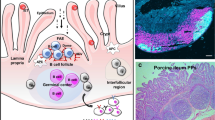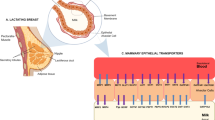Abstract
The chemokine RANTES (regulated upon activation, normal T cell expressed and secreted) plays a significant role in the innate immunity, which is particularly important in the neonatal period. In this study, we aimed to investigate the ability of the neonate to increase plasma levels of RANTES in the first month of life, and the possible impact of breast feeding on this ability. The study population consisted of 125 healthy term neonates that were exclusively breast-fed (n = 62) or formula-fed (n = 63) for at least 1 month after birth. Plasma RANTES concentrations (ELISA) as well as circulating leukocytes and platelets were measured on days 1 and 30 of life. Median RANTES concentrations of the total group showed a significant increase between day 1 [1000 (448–2100) pg/mL] and day 30 [3688 (1488–5400) pg/mL, p < 0.0001], as did median total lymphocyte, T-cell, B-cell, NK-cell and eosinophil counts (all p values <0.0001). Monocyte and platelet counts did not change significantly over the neonatal period. Further analysis according to the mode of feeding showed that RANTES levels as well as leukocyte populations and platelet counts did not differ significantly between breast-fed and formula-fed neonates on either day 1 or 30. Healthy term neonates are capable of increasing plasma RANTES levels during the 1st month after birth independently of the mode of feeding.

Similar content being viewed by others
Abbreviations
- RANTES:
-
regulated upon activation, normal T cell expressed and secreted
References
Arkachaisri T, Ballow M (1999) Developmental immunology of the newborn. Immunol Allergy Clin N Am 19:253–279
Bjorksten B (1999) The intrauterine and postnatal environments. J Allergy Clin Immunol 104:119–127
Cocchi F, DeVico AL, Garzino-Demo A, Arya SK, Gallo RC, Lusso P (1995) Identification of RANTES, MIP-1alpha, and MIP-1beta as the major HIV suppressive factors produced by CD81 T cells. Science 270:1811–1815
Coffey MJ, Woffendin C, Phare SM, Strieter RM, Markovitz DM (1997) RANTES inhibits HIV-l replication in human peripheral blood monocytes and alveolar macrophages. Am J Physiol 272:LlO25–LlO29
de Bont ES, Martens A, van Raman J, Samson G, Fetter WP, Okken A, de Leij LH (1993) Tumor necrosis factor-alpha, interleukin-1 beta, and interleukin-6 plasma levels in neonatal sepsis. Pediatr Res 33:380–383
Delespesse G, Yang LP, Ohshima Y, Demeure C, Shu U, Byun DG, Sarfati M (1998) Maturation of human neonatal CD4+ and CD8+ T lymphocytes into Th1/Th2 effectors. Vaccine 16:1415–1419
Dragic T, Litwin V, Allaway GP, Martin SR, Huang Y, Nagashima KA, Cayanan C, Maddon PJ, Koup RA, Moore JP, Paxton WA (1996) HIV-1 entry into CD41 cells is mediated by the chemokines receptor CC-CKR-5. Nature 381:667–673
Forchielli ML, Walker WA (2005) The role of gut-associated lymphoid tissues and mucosal defence. Br J Nutr 93(Suppl 1):S41–S48
Fotopoulos S, Mouchtouri A, Xanthou G, Lipsou N, Petrakou E, Xanthou M (2005) Inflammatory chemokine expression in the peripheral blood of neonates with perinatal asphyxia and perinatal or nosocomial infections. Acta Paediatr 94:800–806
Hariharan D, Ho W, Cutilli J, Campbell DE, Douglas SD (2000) C-C chemokine profile of cord blood mononuclear cells: selective defect in RANTES production. Blood 95:715–718
Malamitsi-Puchner A, Sarandakou A, Tziotis J, Economou E, Protonotariou E, Rigopoulou O (2004) Chemokines RANTES and interleukin-8 in the perinatal period: changes in serum concentrations. Am J Perinatol 21:235–240
Ng PC, Li K, Leung TF, Wong RP, Li G, Chui KM, Wong E, Cheng FW, Fok TF (2006) Early prediction of sepsis-induced disseminated intravascular coagulation with interleukin-10, interleukin-6, and RANTES in preterm infants. Clin Chem 52:1181–1189
Nickel R, Beck LA, Stellato C, Schleimer RP (1999) Chemokines and allergic disease. J Allergy Clin Immunol 104:723–742
Peters AM, Bertram P, Gahr M, Speer CP (1993) Reduced secretion of interleukin-1 and tumor necrosis factor-alpha by neonatal monocytes. Biol Neonate 63:157–162
Resino S, Bellon JM, Gurbindo D, Munoz-Fernandez MA (2001) Disruption in cytokine and chemokine production by T-cells in vertically HIV-1-infected children. Acta Paediatr 90:989–997
Rollins BJ (1997) Chemokines (review). Blood 90:909–928
Scarlatti G, Tresoldi E, Bjorndal A, Fredriksson R, Colognesi C, Deng HK, Malnati MS, Plebani A, Siccardi AG, Littman DR, Fenyo EM, Lusso P (1997) In vivo evolution of HIV-1 co-receptor usage and sensitivity to chemokine-mediated suppression. Nat Med 3:1259–1265
Shalak LF, Laptook AR, Jafri HS, Ramilo O, Perlman JM (2002) Clinical chorioamnionitis, elevated cytokines, and brain injury in term infants. Pediatrics 110:673–680
Sullivan SE, Sraba SL, Gersting JA, Hutson AD, Theriaque D, Christensen RD, Calhoun DA (2002) Circulating concentrations of chemokines in cord blood, neonates and adults. Pediatr Res 51:653–657
Than S, Tumaliuan JA, Tamma S, Morales M, Bakshi S, Pahwa S (1999) Chemokine pattern in relation to disease state in human immunodeficiency virus-infected children. AIDS Res Hum Retrovir 15:1279–1285
Vigano A, Esposito S, Arienti D, Zagliani A, Massironi E, Principi N, Clerici M (1999) Differential development of type 1 and type 2 cytokines and beta-chemokines in the ontogeny of healthy newborns. Biol Neonate 75:1–8
Zlotnik A, Yoshie O (2000) Chemokines: a new classification system and their role in immunity. Immunity 12:121–127
Author information
Authors and Affiliations
Corresponding author
Rights and permissions
About this article
Cite this article
Sarafidis, K., Diamanti, E., Taparkou, A. et al. Plasma RANTES increase during the first month of life independently of the feeding mode. Eur J Pediatr 166, 819–823 (2007). https://doi.org/10.1007/s00431-006-0329-3
Received:
Accepted:
Published:
Issue Date:
DOI: https://doi.org/10.1007/s00431-006-0329-3




